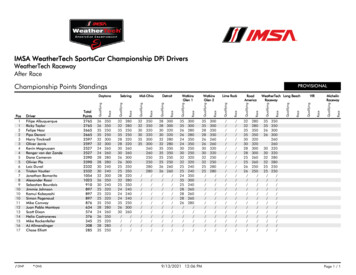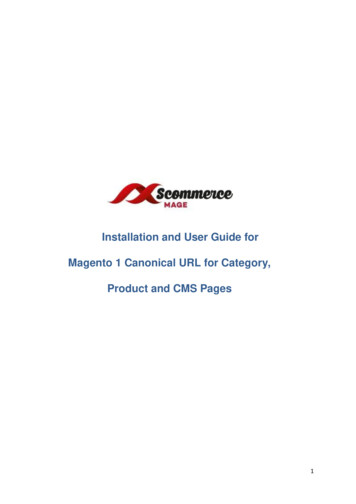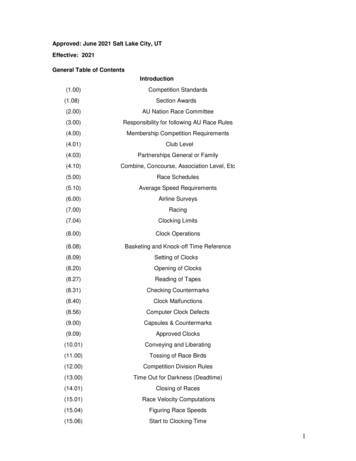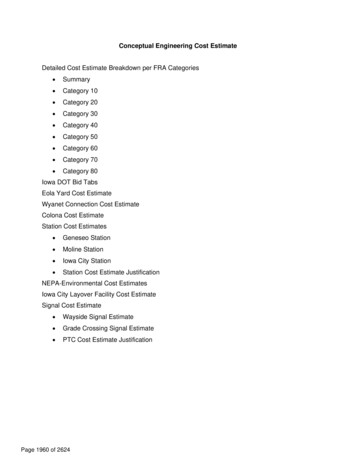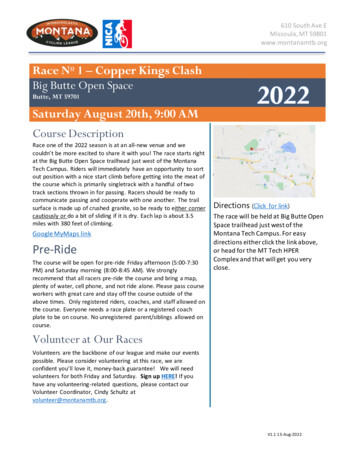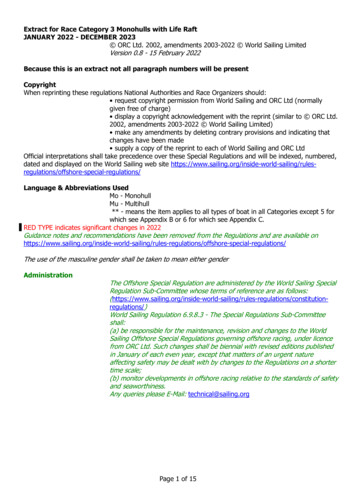
Transcription
Extract for Race Category 3 Monohulls with Life RaftJANUARY 2022 - DECEMBER 2023 ORC Ltd. 2002, amendments 2003-2022 World Sailing LimitedVersion 0.8 - 15 February 2022Because this is an extract not all paragraph numbers will be presentCopyrightWhen reprinting these regulations National Authorities and Race Organizers should: request copyright permission from World Sailing and ORC Ltd (normallygiven free of charge) display a copyright acknowledgement with the reprint (similar to ORC Ltd.2002, amendments 2003-2022 World Sailing Limited) make any amendments by deleting contrary provisions and indicating thatchanges have been made supply a copy of the reprint to each of World Sailing and ORC LtdOfficial interpretations shall take precedence over these Special Regulations and will be indexed, numbered,dated and displayed on the World Sailing web site regulations/offshore-special-regulations/Language & Abbreviations UsedMo - MonohullMu - Multihull** - means the item applies to all types of boat in all Categories except 5 forwhich see Appendix B or 6 for which see Appendix C.RED TYPE indicates significant changes in 2022Guidance notes and recommendations have been removed from the Regulations and are available es-regulations/offshore-special-regulations/The use of the masculine gender shall be taken to mean either genderAdministrationThe Offshore Special Regulation are administered by the World Sailing SpecialRegulation Sub-Committee whose terms of reference are as ld Sailing Regulation 6.9.8.3 - The Special Regulations Sub-Committeeshall:(a) be responsible for the maintenance, revision and changes to the WorldSailing Offshore Special Regulations governing offshore racing, under licencefrom ORC Ltd. Such changes shall be biennial with revised editions publishedin January of each even year, except that matters of an urgent natureaffecting safety may be dealt with by changes to the Regulations on a shortertime scale;(b) monitor developments in offshore racing relative to the standards of safetyand seaworthiness.Any queries please E-Mail: technical@sailing.orgPage 1 of 15
**************SECTION 1 - FUNDAMENTAL AND DEFINITIONS1.01Purpose and Use1.01.1The purpose of the Offshore Special Regulations (OSR) is to establish uniformminimum equipment, accommodation and training standards for monohull andmultihull (excluding proa) boats racing offshore.1.01.2The OSR do not replace, but rather supplement, the requirements ofgovernmental authority, Classification Society certification, the Racing Rules ofSailing (RRS), Equipment Rules of Sailing (ERS), class rules and RatingSystems.1.01.3Use of the OSR does not guarantee total safety of the boat and her crew.Particular attention is drawn to the description of OSRs for inshore racingwhich includes that adequate shelter and or effective rescue is available allalong the course. This is not included in more onerous OSR categories.1.02Responsibility of Person in Charge1.02.1 Under RRS 3 the responsibility for a boat’s decision to participate ina race or continue racing is hers alone. The safety of a boat and hercrew is the sole and inescapable responsibility of the Person inCharge who shall do his best to ensure that the boat is fully found,thoroughly seaworthy and manned by an experienced andappropriately trained crew who are physically fit to face badweather. The person in charge shall also assign a person to take overhis responsibilities in the event of his incapacitation.1.02.2Neither the establishment of the OSR, nor their use by Organizing Authorities,nor the inspection of a boat under the OSR in any way limits or reduces thecomplete and unlimited responsibility of the Person in Charge.1.02.3By participating in a race conducted under the OSR, the person in charge,each competitor and boat owner agrees to reasonably cooperate with theorganizing authority and World Sailing in the development of an independentincident report as specified in 2.021.03Definitions, Abbreviations, Word Usage1.03.1Definitions of Terms used in this documentAbbreviationDescription#Pound force (lbf)ABSAmerican Bureau of ShippingAge DateMonth/year of first launchAISAutomatic Identification SystemsCENComité Européen de NormalisationCoamingThe part of the cockpit, including the transverse after limit, overwhich water would run when the boat is floating level and thecockpit is filled to overflowingCOLREGSInternational Regulations for Preventing Collisions at SeaContainedCockpitA cockpit where the combined area open aft to the sea is less than50% maximum cockpit depth x maximum cockpit widthCPRCardio-Pulmonary ResuscitationCrewmemberEvery person on boardDSCDigital Selective CallingENEuropean NormEPIRBEmergency Position-Indicating Radio BeaconERSWorld Sailing - Equipment Rules of SailingFA StationThe transverse station at which the upper corner of the transommeets the sheerline.Page 2 of 15
First LaunchMonth & year of first launch of the individual boatFoul-WeatherSuitClothing designed to keep the wearer dry and may consist of onepiece or severalGMDSSGlobal Maritime Distress & Safety SystemGNSSGlobal Navigation Satellite SystemGPSGlobal Positioning SystemHatchThe term hatch includes the entire hatch assembly including the lidor cover as part of that assemblyHMPEHigh Modulus Polyethylene (Dyneema /Spectra or equivalent)IMOInternational Maritime OrganisationIMSOThe International Mobile Satellite Organisation, the independent,intergovernmental organisation that oversees Inmarsat’sperformance of its Public Service Obligations for the GMDSS andreports on these to IMOINMARSATInmarsat Global Limited is a private company that provides GMDSSsatellite distress and safety communications, plus generalcommunications via voice, fax and dataISAFInternational Sailing Federation- (now World Sailing)ISOInternational Standard Organization or International Organizationfor Standardization.ITUInternational Telecommunications UnionJackstayA securely fastened webbing or rope which permits a crewmemberto move from one part of the boat to another without having tounclip a safety harness tether.LHHull Length as defined by the ERSLifelineRope or wire line rigged as guardrail / guardline around the deckLSAIMO International Life-Saving Appliance CodeLWL(Length of) loaded waterlineMonohullA boat with one hullMoveableBallastMaterial carried for the sole purpose of increasing weight and/orinfluencing stability and/or trim and which may be movedtransversely but not varied in weight while a boat is racingMultihullA boat with more than one hullOpen CockpitA cockpit that is not a Contained Cockpit.ORCOffshore Racing Congress (formerly Offshore Racing Council)OSROffshore Special Regulation(s)PermanentlyInstalledThe item is effectively built-in by e.g. bolting, welding, glassingetc. and may not be removed for or during racing.PLBPersonal Locator BeaconPrimaryLaunchMonth & Year of first launch of the first boat of the productionseries or first launch of a non-series boatProaAsymmetric CatamaranRodeRope, chain, or a combination of both, which is used to connect ananchor to the boat.RRSWorld Sailing - Racing Rules of SailingSafety LineA tether used to connect a safety harness to a strong pointSARSearch and RescueSARTSearch and Rescue TransponderPage 3 of 15
SecurelyFastenedHeld strongly in place by a method (e.g. rope lashings, wing-nuts)which will safely retain the fastened object in severe conditionsincluding a 180 capsize and allows for the item to be removedand replaced during racingSOLASSafety of Life at Sea ConventionSSSThe Safety and Stability Screening numeralStatic BallastMaterial carried for the sole purpose of increasing weight and/or toinfluencing stability and/or trim and which is not moved or variedin weight while a boat is racingStatic SafetyLineA safety line (usually shorter than a safety line carried with aharness) kept clipped on at a work-stationSTIXISO 12217-2 Stability IndexVariableBallastWater carried for the sole purpose of influencing stability and/ortrim and which may be varied in weight and/or moved while aboat is racing.WaterlineThe water surface when the boat is floating in measurement trimWorld Sailingformerly the International Sailing Federation or *The words "shall" and "must" are mandatory, and "should" and "may" arepermissive.The word "yacht" shall be taken as fully interchangeable with the word "boat".SECTION 2 - APPLICATION & GENERAL REQUIREMENTS2.01Categories of EventsOrganizing Authorities shall select from one of the following categories andmay modify the OSR to suit local conditions2.01.4 Category 3Races across open water, most of which is relatively protected or close toshorelines.2.02Incident ReportingThe Organizing Authority of a race will establish whether any incidentsoccurred, which if reported would be likely to be relevant to evolving theOffshore Special Regulations, the plan review process, or in increasing safety.The Organizing Authority will follow any guidelines issued by World Sailingconcerning incident reporting.2.03InspectionA boat may be inspected at any time. If she fails to comply with the OSR herentry may be rejected or she will be subject to protest2.04General Requirements2.04.1All equipment required by OSR shall:a)function properlyb)be regularly checked, cleaned and servicedc)if it has an expiry date, it will not have exceeded its expiry date whilst racingd)when not in use be stowed in conditions in which deterioration is minimisede)be readily accessiblef)be of a type, size and capacity suitable and adequate for the intended use andsize of the boat.2.04.2Heavy items shall be permanently installed or securely fastenedSECTION 3 - STRUCTURAL FEATURES, STABILITY, FIXED EQUIPMENTA boat shall be/have:3.01Strength of Build and Rig3.01.1Properly rigged, fully seaworthy and shall meet the OSR3.01.2Equipped with shrouds and at least one forestay that shall remain connectedto the mast and the boat while racing (not applicable to boats with freestanding masts)Page 4 of 15
43.04.1Mo0,1,2,3Mo0,1,2,33.04.2Mo3Mo3a) 4Mo0,1,2,3,4Mo0,1,2,3,43.06.2a)b)Mo0,1,2,3,4The forestay referenced above shall be sized and connected in a way thatensures it is capable of withstanding the full sailing loads independent of anyheadsail luff load capacityWatertight and Structural Integrity of a BoatEssentially watertight and all openings shall be capable of being immediatelysecured. Centreboard, daggerboard trunks and the like shall not open into theinterior of a hull except via a watertight maintenance hatch with the openingentirely above the WaterlineEffective 1 January 2023, at a haul-out within two years prior to the event, theowner or his/her representative shall inspect the integrity of the keel andrudder following the recommendations in Appendix L.Effective 1 January 2022: Inspection after Grounding – an appropriatelyqualified person shall conduct an internal and external inspection after eachunintentional groundingStability - MonohullsAble to demonstrate compliance with ISO 12217-2* design category B orhigher, either by EC Recreational Craft Directive certification having obtainedthe CE mark or the designer’s declaration* The latest effective version of ISO 12217-2 should be used unless the boatwas already designed to a previous versionWhere compliance in accordance with 3.04.1 cannot be demonstrated, able todemonstrate either:a STIX value not less than 23; andAVS not less than 130 - 0.005*m, but always 95 , (where “m” is the massof the boat in the minimum operating condition as defined by ISO 12217-2);anda minimum righting energy not less than m*AGZ 57000 (where AGZ is thepositive area under the righting lever curve in the minimum operatingcondition, expressed in kg metre degrees from upright to AVS); orStability Index in ORC Rating System of not less than 103; orIRC SSS Base value of not less than 15Exits - MonohullsAt least two exits if 8.5 m (28’) LH and greater and with a Primary Launchafter 1994. One exit shall be located forward of the foremost mast exceptwhere structural features prevent its installationThe following minimum clear hatch openings if First Launch after 2013:a circular hatch with diameter 450 mm (18”); orany other shape with minimum dimension of 380 mm (15”) and minimum areaof 0.18 m² (1.9 ft²) (see figure 1)Figure 1 - Measurements of Minimum Clear 3,4b)Hatches & CompanionwaysHatch covers forward of the maximum beam station shall not open toward theinterior of the boat, except hatches in the side of a coachroof or ports havingan area of less than 0.071 m² (110 in²)A hatch, including a hatch over a locker shall be:permanently attached and capable of being firmly shut immediately andremaining firmly shut in a 180 capsizeabove the water when the boat is heeled 90 A boat may have a maximum of two hatches on each side of centerline thatPage 5 of 15
)**ido not conform to the requirement in b), provided that the opening of each isless than 0.071² m (110 in²)Hatches not conforming with 3.08.1 and 3.08.2 shall be clearly labelled andused in accordance with the following instruction “NOT TO BE OPENED ATSEA”Companionway hatches:fitted with a strong securing arrangement which shall be operable from theexterior and interior even when the boat is invertedblocking devices:capable of being retained in position with the hatch open or shutsecured to the boat (e.g. by lanyard) for the duration of the racepermit exit in the event of inversionif a monohull with Open Cockpit(s):a companionway sill that does not extend below the local sheerline; ora companionway in full compliance with ISO 11812 category Aif a monohull with Contained Cockpit(s) where the companionway extendsbelow the local sheerline, panels capable of blocking the companionway up tothe level of the local sheerline whilst giving access to the interior.CockpitsCockpits that self-drain quickly by gravity at all angles of heel and arepermanently incorporated as an integral part of the boatA cockpit sole at least 2% LWL above the waterline (or in IMS boats with FirstLaunch before 2003, at least 2% L above the waterline)A bow, lateral, central or stern well is a cockpit for the purposes of OSR 3.09Cockpit VolumeThe maximum combined volume below lowest coamings of all containedcockpits shall be:primary launch before April 1992: 9% (LWL x maximum beam x freeboardabreast the cockpit)primary launch after March 1992 as above for the appropriate category exceptthat ”lowest coamings” shall not include any aft of the FA station and noextension of a cockpit aft of the working deck shall be included in calculationof cockpit volumeCockpit DrainsCockpit drain cross section area of unobstructed openings (after allowance forscreens if fitted) shall be at least that of:2 x 25 mm (1”) diameter or equivalent for a boat less than 8.5 m (28’) LH4 x 20 mm (3/4”) diameter or equivalent for a boat 8.5 m (28’) LH or greaterSea Cocks or ValvesPermanently installed sea cocks or valves on all through-hull openings belowthe waterline except for integral deck scuppers and instrument through-hullsSheet WinchesSheet winches mounted in such a way that an operator is not required to besubstantially below deckMast StepThe heel of a keel stepped mast securely fastened to the mast step oradjoining structurePulpits, Stanchions, LifelinesThe perimeter of the deck surrounded by system of lifelines and pulpits asfollows:Continuous lifelines fixed only at (or near) the bow and stern. However a gateon each side of a boat is permitted. Except at its end fittings and at gates, themovement of a lifeline in a fore-and-aft direction shall not be constrained.Temporary sleeving shall not modify tension in the lifeline.Minimum heights of lifelines and pulpit rails above the working deck andvertical openings:upper: 600 mm (24”)Page 6 of 15
)b)c)**d)**e)intermediate: 230 mm (9”)vertical opening: no greater than 380 mm (15”) except that on a boat with aPrimary Launch before 1993 where it shall be no greater than 560 mm (22”)a boat less than 8.5 m (28’) LH may use a single lifeline system with a heightbetween 450 mm (18”) and 560 mm (22”)Lifelines permanently supported at intervals of not more than 2.2 m (7'-21/2”) and shall not pass outboard of supporting stanchionsPulpit and stanchion bases permanently installed with pulpits and stanchionsmechanically retained in their basesThe outside of pulpit and stanchion base tubes no further inboard from theedge of the working deck than 5% of maximum beam or 150 mm (6”),whichever is greater, nor further outboard than the edge of the working deckStanchions straight and vertical except that:within the first 50 mm (2”) from the deck, stanchions shall not be displacedhorizontally from the point at which they emerge from the deck or stanchionbase by more than 10 mm (3/8”)stanchions may be angled to not more than 10 from vertical at any pointabove 50 mm (2”) from the deckA bow pulpit may be open provided the opening between the pulpit and anypart of the boat does not exceed 360 mm (14”)Figure 2 - Diagram Showing Pulpit OpeningLifelines may terminate at or pass through adequately braced stanchions setinside and overlapping the bow pulpitWhen a deflecting force of 4 kg (8.8 #) is applied to a lifeline at the mid-pointof the longest span between supports that are aft of the mast, the deflectionshall not exceed:50 mm (2”) for an upper or single lifeline120 mm (4 ¾”) for an intermediate lifelineSpare numberSpare numberSpare numberLifeline SpecificationsLifelines of stranded stainless steel wireThe minimum diameter is specified in table 8 belowStainless steel lifelines shall be uncoated and used without close-fittingsleeving, however, temporary sleeving may be fitted provided it is regularlyremoved for inspection.A lanyard of synthetic rope may be used to secure lifelines provided the gap itcloses does not exceed 100 mm (4”). This lanyard shall be replaced annuallyAll components of the lifeline enclosure system shall have a breaking strengthno less than the lifelinePage 7 of 15
**Table 8LHWire Min.lifelinediameterHMPE rope (Singlebraid) min. lifelinediameterHMPE Core (Braid onbraid) min. lifelinediameterunder8.5m (28')3mm (1/8")4mm (5/32")4mm (5/32")8.5m 13m4mm (5/32")5mm (3/16")5mm (3/16")over 13m(42' 8")5mm (3/16")5mm (3/16")5mm .273.27.1Toe Rail or Foot - StopPermanently installed toe rail of minimum height 25 mm (1”), located as closeas practicable to the stanchion bases, around the foredeck from abreast themastAn additional lifeline of between 25-50 mm (1-2”) high is permitted in lieu of atoe rail on a boat with Primary Launch before 1984.ToiletPermanently installed toilet or fitted bucketBunksPermanently installed bunksCooking FacilitiesPermanently installed cooking stove, capable of being operated safely at sea,with fuel shutoff controlDrinking Water Tanks & Drinking WaterDrinking Water TanksPermanently installed delivery pump and water tank(s)Emergency Drinking WaterAt least 9 l (2.4 US Gal) of drinking water for emergency use in a dedicatedand sealed container or container(s)Hand HoldsAdequate hand holds fitted below deckBilge Pumps and Bucketstwo strong buckets, each with a lanyard and of at least 9 l (2.4 US Gal)capacityone permanently installed manual bilge pumpAll required permanently installed bilge pumps shall be operable with allcockpit seats, hatches and companionways shut and with permanentlyinstalled discharge pipe(s) of sufficient capacityBilge pumps shall not be connected to cockpit drains and shall not dischargeinto a Closed CockpitBilge pumps shall be readily accessible for maintenance and for clearing outdebrisAll removable bilge pump handles retained by a lanyardCompassMarine magnetic compass capable of being used as a steering compass:Permanently installed marine magnetic steering compass, independent of anypower supply, correctly adjusted with deviation carda second compass which may be hand-held and/or electronicHalyards.A minimum of two halyards, each capable of hoisting a sail, on each mastNo halyard shall be locked, lashed or otherwise secured to the mast in a waythat requires a person to go aloft in order to lower a sail in a controlledmanner, except for a headsail in use with a furling device.Navigation Lightsthat conform to the International Regulations for Preventing Collisions at Sea(Part C and Technical Annex I) and shall be exhibited as required by thosePage 8 of 15
Mo0,1,2,3Mu1,2,3.29.83.29.13regulations.mounted above sheerline and so that they will not be masked by sails or theheeling of the boatreserve lights having the same specifications as above, and that can bepowered independentlyspare bulbs (not required for LED)Engines, Generators, FuelPropulsion Enginesengines and associated systems installed in accordance with theirmanufacturers’ guidelines and suitable for the size and intended use of theboatan engine which provides a minimum speed in knots of (1.8 x LWL inmetres) or ( LWL in feet)either an inboard or outboard engine, with associated power supply systems,all securely fastenedan inboard combustion engine shall have a permanently installed exhaust,cooling system, fuel supply, fuel tank(s) and shall have adequate heavyweather protectionan inboard electrical engine, when fitted, shall be provided with a permanentlyinstalled power supply, adequate heavy weather protection and have anengine control system.GeneratorIf an optional generator separate from the propulsion engine is carried, it shallbe installed in accordance with the manufacturer’s guidelinesLiquid Fuel SystemsAll fuel tanks for storage of liquid fuels shall be rigid (but may havepermanently installed flexible linings) and shall have a shutoff valveAt the start a boat with a combustion engine shall carry sufficient fuel to meetcharging requirements for the duration of the race and to motor at the aboveminimum speed for at least 5 hoursBattery Systemsa dedicated engine/generator starting battery when an electric starter is theonly method for starting the engine and/or separate generatorbatteries installed after 2011 shall be of the sealed type from which liquidelectrolyte cannot escapeAt the start a boat with an electric engine shall carry sufficient capacity tomeet electrical requirements for the duration of the race and to motor at theabove minimum speed for at least 5 hoursCommunications Equipment, GPS, Radar, AISa marine radio transceiver with an emergency antenna when the regularantenna depends upon the mastif the marine radio transceiver is a VHF:a minimum rated output power of 25 Wa masthead antenna and co-axial feeder cable with not more than 40% powerlossbe DSC capable if installed after 2015DSC capable VHF transceivers shall be programmed with an assigned MMSI(unique to the boat), be connected to a GPS receiver and be capable ofmaking distress alert calls as well as sending and receiving a DSC positionreport with another DSC equipped stationa hand-held marine VHF transceiver, watertight or with a waterproof cover.When not in use to be stowed in a grab bag or emergency container (see OSR4.21)a second radio receiver, which may be the handheld VHF in 3.29.5 above,capable of receiving weather bulletinsa GPSan AIS Transponder which either:Page 9 of 15
s the masthead VHF antenna via a low loss AIS antenna splitter; orhas a dedicated AIS antenna not less than 38 cm (15”) in length mounted withits base not less than 3 m (10’) above the Waterline and co-axial feeder cablewith not more than 40% power lossSECTION 4 - PORTABLE EQUIPMENTA boat shall have:4.01Sail Letters & Numbers4.01.1Identification on sails which complies with RRS 77 and RRS Appendix G4.01.2An alternative means of displaying identification as required under RRSAppendix G for a mainsail, to be displayed when none of the numbered sailsare set4.02Search and Rescue Visibility4.03Soft Wood PlugsA tapered soft wood plug stowed adjacent to every through-hull opening4.04Jackstays and Clipping Points4.04.1Permanently Installed fittings for jackstay ends and clipping points4.04.2Jackstays which shall:a)be independent on each side of the deckb)enable a crewmember to move readily between the working areas on deckand the cockpit(s) with the minimum of clipping and unclipping operationsc)have a breaking strength of 2040 kg (4500#) and be uncoated and nonsleeved stainless steel 1 x 19 wire of minimum diameter 5 mm (3/16”),webbing or HMPE rope4.04.3Clipping points which shall:a)be adjacent to stations such as the helm, sheet winches and masts, wherecrewmembers workb)enable a crewmember to clip on before coming on deck and unclip after goingbelowc)enable two-thirds of the crew to be simultaneously clipped on withoutdepending on jackstays4.05Fire Fighting Equipment4.05.1A fire blanket adjacent to every cooking device4.05.22 fire extinguishers, each with 2 kg of dry powder or equivalent, in differentparts of the boat4.06Anchors4.06.22 un-modified anchors that meet the anchor manufacturer’s recommendationbased on the boat’s dimensions with suitable combination of chain and rope,ready for immediate assembly, and ready for deployment within 5 minutesexcept that for a boat less than 8.5 m (28’) LH there shall be 1 anchormeeting the same criteria.4.07Flashlights and SearchlightsWatertight lights with spare batteries and bulbs as follows:a)a searchlight, suitable for searching for a person overboard at night and forcollision avoidanceb)a flashlight in addition to 4.07 a)4.08First Aid Manual and First Aid KitA First Aid Manual and First Aid Kit. The contents and storage of the First AidKit shall reflect the likely conditions and duration of the passage, and thenumber of crew4.09FoghornA foghorn4.10Radar Reflector4.10.1A passive radar reflector with:a)octahedral circular plates of minimum diameter 30 cm (12”), orb)octahedral rectangular plates of minimum diagonal dimension 40 cm (16”), orPage 10 of 15
2MoMu2MoMu1,2ivvviviia non-octahedral reflector with a documented Root Mean Square minimumRadar Cross Section (RCS) area of 2 m² (22 ft²) from 0-360 of azimuth and 20 of heelNavigation EquipmentNavigational charts (not solely electronic), light list and chart plottingequipmentSafety Equipment Location ChartA safety equipment location diagram in durable waterproof material, clearlydisplayed in the main accommodation, marked with the location of principalitems of safety equipmentDepth, Speed and Distance InstrumentsA knotmeter or distance measuring instrument (log)A depth sounderSpare NumberEmergency SteeringAn emergency tiller capable of being fitted to the rudder stock except whenthe principal method of steering is by means of an unbreakable metal tillerthere are two methods (e.g. tillers, wheels) of controlling a rudder, neither ofwhich shares components with the other except for the rudder stock.A proven method of emergency steering with the rudder disabledTools and Spare PartsTools and spare parts, suitable for the duration and nature of the passageAn effective means to quickly disconnect or sever the standing rigging fromthe boatBoat's nameThe boat’s name on miscellaneous buoyant equipment, such as lifejackets,cushions, lifebuoys, recovery slings, grab bags etc.Retro-reflective materialMarine grade retro-reflective material on lifebuoys, recovery slings, liferaftsand lifejacketsEPIRBsLiferaftsLiferaft ConstructionOne or more inflatable liferafts with a total capacity to accommodate at leastthe total number of people on board which complies with:SOLAS LSA Code 1997 Chapter IV or later version; orISO 9650-1:2005, Type 1, Group A - Small Craft - Inflatable; orISAF liferafts manufactured before 2016 until replacement is due at end ofservice life; orORC liferafts manufactured before 2003 until replacement is due at end ofservice lifeMinimum Liferaft EquipmentA SOLAS liferaft shall contain as a minimum a SOLAS A pack;An ISO 9650 liferaft shall contain as a minimum Pack 2 (less than 24 hourpack);The minimum contents of the ISO liferaft equipment packs are listed below.Not all items are necessarily packed within the liferaft. Some items arepermitted to be carried within an accompanying waterproof grab bag whichshall be in a readily accessible location:Portable buoyant bailer easily operable by hand2 spongesPair of buoyant paddles with handles (not mitts) tied into raft adjacent to anentranceWhistleWaterproof torch with 6
IMO International Maritime Organisation IMSO The International Mobile Satellite Organisation, the independent, intergovernmental organisation that oversees Inmarsat's performance of its Public Service Obligations for the GMDSS and reports on these to IMO INMARSAT Inmarsat Global Limited is a private company that provides GMDSS .
